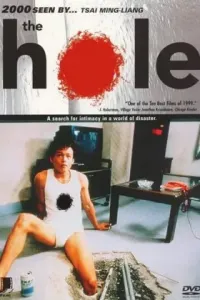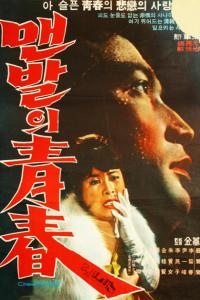
The Hole (1998): A Post-Millennial Plague, a Flooded Apartment, and the Dance of Human Connection
Tsai Ming-liang's The Hole (1998), a mesmerizing and deeply idiosyncratic film, plunges viewers into the claustrophobic confines of a dystopian Taipei on the cusp of the new millennium. As the year 2000 approaches, a mysterious virus is spreading, causing people to regress to animalistic states, prompting the government to issue mandatory building evacuations and plumbing repairs. Our story unfolds in a dilapidated apartment building, where a cynical, uncooperative man (played by the director's muse, Lee Kang-sheng) refuses to leave his water-damaged flat, despite the constant dripping from the ceiling. Directly above him lives a solitary woman (Yang Kuei-mei) who is also stubbornly holding onto her home. The titular "hole" in the ceiling, a literal breach between their apartments, becomes a conduit not just for water, but for an unexpected, bizarre, and ultimately profound connection, forcing two deeply isolated individuals into an unwilling, yet strangely tender, coexistence amidst the societal collapse around them.
What truly elevates The Hole is Tsai Ming-liang's signature minimalist approach, which transforms a simple premise into a rich tapestry of human experience. The film is characterized by its sparse dialogue, deliberate pacing, and prolonged, static shots, forcing the audience to truly observe the characters' quiet desperation, subtle gestures, and mundane routines. This stark realism is brilliantly punctuated by surprising, almost surreal musical numbers, where the two protagonists spontaneously break into elaborately choreographed song-and-dance routines set to classic Chinese pop tunes of Grace Chang. These fantastical interludes, jarringly juxtaposed against the film's bleak backdrop and the characters' otherwise withdrawn demeanors, serve as both a stark contrast to their grim reality and a poignant expression of their inner desires for connection, joy, and perhaps even escape from their impending doom. It's a masterful blend of the mundane and the magical, reflecting the absurdities and fleeting moments of beauty found even in the bleakest circumstances.
The Hole stands as a hauntingly prescient and deeply affecting work that, despite its specific pre-millennial anxieties, speaks to universal themes of loneliness, urban decay, and the enduring human need for connection in an increasingly fragmented world. It's a powerful statement on the fragility of civilization and the unexpected ways intimacy can form under duress. The film's unique blend of stark realism, subtle humor, and fantastical musical sequences makes it an unforgettable cinematic experience that challenges conventional storytelling. It premiered at the 1998 Cannes Film Festival, where it won the FIPRESCI Prize. The entire film features very little dialogue, relying heavily on visual storytelling and the expressive performances of Lee Kang-sheng and Yang Kuei-mei, who portray their characters' isolation and gradual rapport with profound depth. The plot's inspiration clearly draws from the widespread Y2K anxiety present at the time, and the "disease" itself is never fully explained, adding to the film's unsettling ambiguity.





